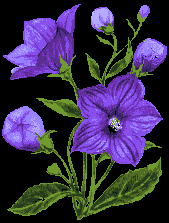

Aromatherapy, commonly associated with complementary and alternative medicine (CAM), is the use of volatile liquid plant materials, known as essential oils (EOs), and other aromatic compounds from plants to affect someone's mood or health.
The word was coined in the 1920s by French chemist Rene Maurice Gattefosse, who devoted his life to researching the healing properties of essential oils after a lucky accident in his perfume laboratory. (In the accident, he lit his arm on fire and thrust it into the nearest cold liquid, which happened to be a vat of lavender oil. Much to his amazement, the burn quickly healed without a scar.)
The main branches of aromatherapy include:
Clinical aromatherapy (as part of pharmacology and pharmacotherapy)
Aromachology (the psychology of odors and their effects on the mind)
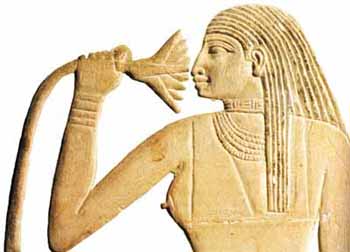
Historically aromatherapy has been used for thousands of years for healing and spiritual rituals. Aromatherapy and its various uses was a sacred practice in most traditional cultures -- Egypt, India, China, Persia, Hebrew, Maya, and Greece.
The Ancient Egyptians have documented their utilization of natural oils from around 3,500 BC. Some of the ingredients that Egyptians used therapeutically were spikenard, frankincense, citrus fruits, myrrh, oregano, and cedar. Some scholars believe that a spikenard ointment may have been used by Mary Magdalen to anoint the feet of Christ prior to the Last Supper.
In ancient India, essential oils and incense were used Ayurveda, the indigenous system of medicine, has used floral and other herbal essences for thousands of years. Ayurvedic practitioners abundantly utilized herbal essences for both psychological and physical ailments, in addition to incense aromatherapy. According to Ayurveda, an individual's qualities are harmonized when the inherent qualities of various medicinal herbs and flowers are introduced. According to Ayurveda, herbal ingredients may be prepared as natural incense, and used to prevent infections, purify one's environmental atmosphere, and energize the vital life airs of the body.
In the traditional Chinese system, the second oldest in continuous practice in the world today, the use of a sophisticated pharmacology based on the Five Element theory taste, and the energetic classifications, is strongly reminiscent of the Ancient Indian school of medicine.
Aroma therapy in Europe can be traced back to the Greeks and Romans, who used essential oils for various medicinal purposes. The use of fumigation aroma therapy was considered to be of primary importance as far back as the time of Hippocrates. Two principle methods of administering the healing systems, fumigation and inhalation, are easily achieved through the use of herbal scents. Since it may be used environmentally or for specific applications, it has become the aroma therapy of choice for countless people throughout the world. Daily use of incense helped prevent disease, promotes a longer life, harmonize one's psycho-physical constitution, and increases mental clarity.
Today, aromatherapy is a very active movement in Europe, especially in France where it is now a recognized medicine reimbursed by medical insurance.
Plants from all over the world contain useful essential oils. These highly volatile oily substances to which the plant owes its perfume and flavor, are present between the cells and act as plant hormones, regulators, and catalysts. They may be considered as representing the vital elements or life force within the plant. Extraction methods are of utmost importance with purity being imperative in order to obtain good therapeutic results.
Aromatherapy requires an extremely high quality of essential oils. Synthetic substances cannot replace the real product. There are hundreds of chemical components in essential oils. Most of them are in minute quantities, and yet it is the precise combinations and ratios of elements which render each oil powerful. As a result, solvents or preservatives are not used in the preparation of first-quality essential oils. A steam-distillation method of extraction is used instead. This process consists of sending steam throughout the plants, which evaporates oils. The steam is then condensed and the oils separate from the water. This method yields a high quality oil. The best oils come from wild organic plants. The amount of oils found in each plant varies greatly and this is reflected in the price.

![]() Basil: a nerve tonic for insomnia, congestion and colds
Basil: a nerve tonic for insomnia, congestion and colds
![]() Clove Oil: an antiseptic used for toothaches,wounds and respiratory infections.
Clove Oil: an antiseptic used for toothaches,wounds and respiratory infections.
![]() Eucalyptus Oil: clears respiratory passages good for skin infections
Eucalyptus Oil: clears respiratory passages good for skin infections
![]() Frankincense: for all catarrh conditions, ulcers, boils, skin care, and laryngitis
Frankincense: for all catarrh conditions, ulcers, boils, skin care, and laryngitis
![]() Geranium: calming effect on the nervous system, kidney stones, skin care
Geranium: calming effect on the nervous system, kidney stones, skin care
![]() Lemon: counteracts stomach acidity, powerful bactericide
Lemon: counteracts stomach acidity, powerful bactericide
![]() Mint: headaches and vomiting, fevers and colds
Mint: headaches and vomiting, fevers and colds
![]() Orange oil: sedative, slightly hypnotic, indicated for cardiac spasms
Orange oil: sedative, slightly hypnotic, indicated for cardiac spasms
When aromatherapy is used for the treatment or prevention of disease, a precise knowledge of the bioactivity and synergy of the essential oils used, knowledge of the dosage and duration of application, as well as, naturally, a medical diagnosis, are required. In the Anglo-Saxon world, even among "natural" practitioners like herbalists or naturopaths, aromatherapy is regarded more as an art form than a valid healing science.
At best, it is viewed as a complementary and seldom the only treatment prescribed. On the continent, especially in France, where it originated, aromatherapy is incorporated into mainstream medicine. There, the use of the anti-septic properties of oils in the control of infections is emphasized over the more "touchy feely" approaches familiar to English speakers. In France some essential oils are regulated as prescription drugs, and thus administered by a physician. In many countries they are included in the national pharmacopeia, but up to the present moment aromatherapy as science has never been recognized as a valid branch of medicine in the United States, Russia or Germany.
Essential oils, phytoncides and other natural VOCs work in different ways. At the scent level they activate the limbic system and emotional centers of the brain. When applied to the skin (commonly in form of "massage oils" i.e. 1-10% solutions of EO in carrier oil) they activate thermal receptors, and kill microbes and fungi. Internal application of essential oil preparations (mainly in pharmacological drugs; generally not recommended for home use apart from dilution - 1-5% in fats or mineral oils, or hydrosoles) may stimulate the immune system, urine secretion, may have antiseptic activity etc. Different essential oils have very different activity; they are studied in pharmacology and aromachology.
It is significant to note the concept of chemotype in essential oil chemistry. Eucalyptus, for example, has many species, such as Eucalyptus globulus (main component is 1,8 cineole), Eucalyptus citriodora (citral), Eucalyptus menthol, and others. Properties of the essential oils of the same generic (common) name are not all the same; they can differ widely in their chemical components and in their therapeutic actions. Likewise, their chemical makeup depends on the method of extraction (e.g. pressed and distilled bergamot oil have different uses). The practitioner must be aware of these factors.
While the practice of aromatherapy is sometimes thought to be confined to inhalation, it may include various methods, including:
Aromatherapy is based mainly on the following therapeutic effects:
Fragrances can have a relaxing effect measured as an increase in alpha brain waves.
One of the best known essential oils for aromatherapy is lavender, which is recommended by practitioners for treating wounds, to enhance memory, and to aid sleep by combating anxiety and insomnia. Other popular scents include eucalyptus, rose, jasmine and bergamot.
Aromatherapy is among the fastest growing fields in alternative and holistic medicine. Aromatherapy is sometimes used in clinics and hospitals for treatment of pain relief, for labor pain, for relieving pain caused by the side effects of the chemotherapy, and for the rehabilitation of cardiac patients.
Skeptics argue that while pleasant scents can be relaxing, lowering stress and related effects, there is currently insufficient scientific proof of the effectiveness of aromatherapy. Like many alternative therapies, few controlled, double-blind studies have been carried out - a common explanation is that there is little incentive to do so if the results of the studies are not patentable.
There are some treatments generally accepted in Western medicine to give a form of relief for the airways in case of cold or flu, such as mint and eucalyptus essential oils. Skeptical literature often depicts aromatherapy as based on anecdotal evidence of its benefits rather than proof that aromatherapy can cure diseases. Some skeptics acknowledge that aromatherapy has limited scientific support but argue that its claims go beyond the data or that the studies are not adequately controlled and peer reviewed. If there can be positive effects, there can also be negative ones if used incorrectly or in bad combinations especially with traditional pharmacology.
The term "aromatherapy" has been applied to such a wide range of products that almost anything which contains essential oils is likely to be called an "aromatherapy product", rendering the term somewhat meaningless in that context.
Some proponents of aromatherapy believe that the claimed effect of each type of oil is not caused by the chemicals in the oil interacting with the senses, but that the oil contains a distillation of the "life force" of the plant from which it is derived that will "balance the energies" of the body and promote healing or well-being by purging negative vibrations from the body's energy field. Arguing that there is little scientific evidence that healing can be achieved, or that the claimed "energies" even exist, many skeptics reject this form of aromatherapy as pseudoscience or even quackery.
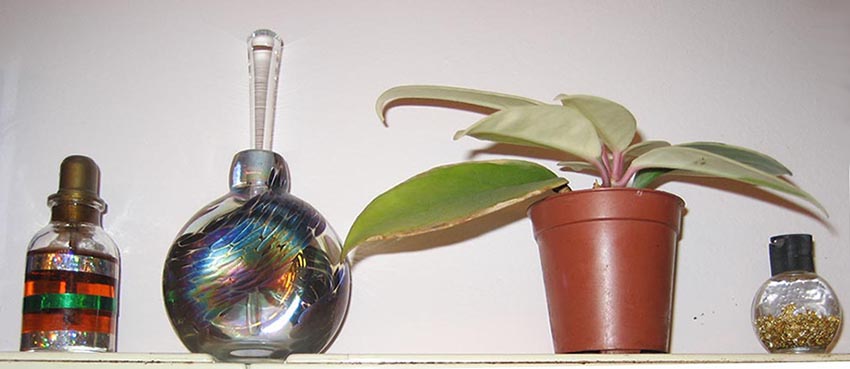
March 2016
When I visited Egypt in December 2000, a healer gave me a small sealed bottle of essential oils (left) and a bottle of gold nuggets in water (right). I've never opened either bottle but enjoy looking at them. I'm not much into alternative healing - as we heal when programmed to if ever - but have briefly studied and posted many of the endless modalities, among them Aromatherapy.
4 Techniques to Relieve Joint Pain Using Essential Oils Epoch Times - March 1, 2016
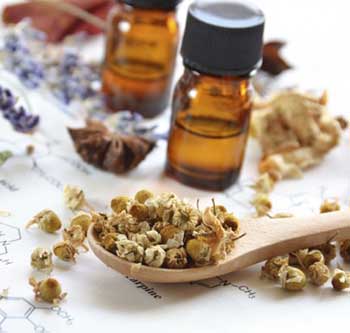
Joint pain may result from injuries, rheumatism, arthritis, or by maintaining bad posture for long periods or time. Essential oils are widely used for relieving joint pain due to their anti-rheumatic, anti-inflammatory, and antispasmodic properties. These effective oils may be used individually or blended together before they are applied to the affected area.
Technique 1: Massage Clove Oil on the Affected Area
Technique 2: Apply a Blend of Essential Oils
Technique 3: Bath Soak With Oils
Technique 4: Hot and Cold Compresses
Essential Oils for Pain: Mints, Resins, and Rhizomes Epoch Times - May 14, 2015
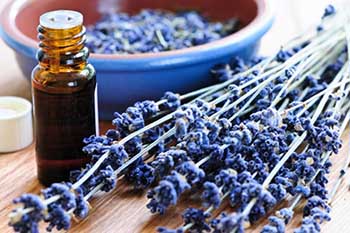
Essential oils are fascinating for their ability to change mood through scent. But they do much more than just relieve depression and anxiety. Some also treat pain. Before reaching for aspirin, ibuprofen, Tylenol, or some prescription muscle relaxer, consider essential oils first. They can be very effective - addressing pain right at the source - and are without the side effects associated with painkiller drugs: liver damage, nausea, and increased risk for heart attack and stroke. For pain, essential oils are applied directly to the painful area and massaged in. Experts insist on diluting essential oils in a carrier oil (such as jojoba, coconut, or almond). Remember: a little goes a long way. Consult a qualified herbalist or Aromatherapist for best results.
How to Use Essential Oils Properly and Conditions They Can Remedy Epoch Times - October 17, 2014

Essential oils are a unique branch of herbal medicine that utilizes the medicinal properties found in the essential oils of various plants. Through the different processes of distillation, the volatile constituents of the plant's oil are extracted from its flowers, leaves, branches, or roots. The oils then exert much of their therapeutic effect through their pharmacological properties and small molecular size making it very easy to penetrate bodily tissues, and help remedy many conditions.
Short-term exposure to essential oils lowers blood pressure and heart rate PhysOrg - November 29, 2012
The scents which permeate our health spas from aromatic essential oils may provide more benefits than just a sense of rest and well-being. According to a new study, the essential oils which form the basis of aromatherapy for stress relief are also reported to have a beneficial effect on heart rate and blood pressure following short-term exposure - and may therefore reduce the risk of cardiovascular se. However, on the downside, those beneficial effects were reversed when exposure to essential oils lasted more than an hour.
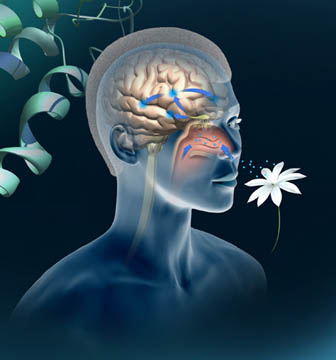
Olfaction, Sense of Smell